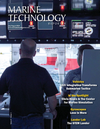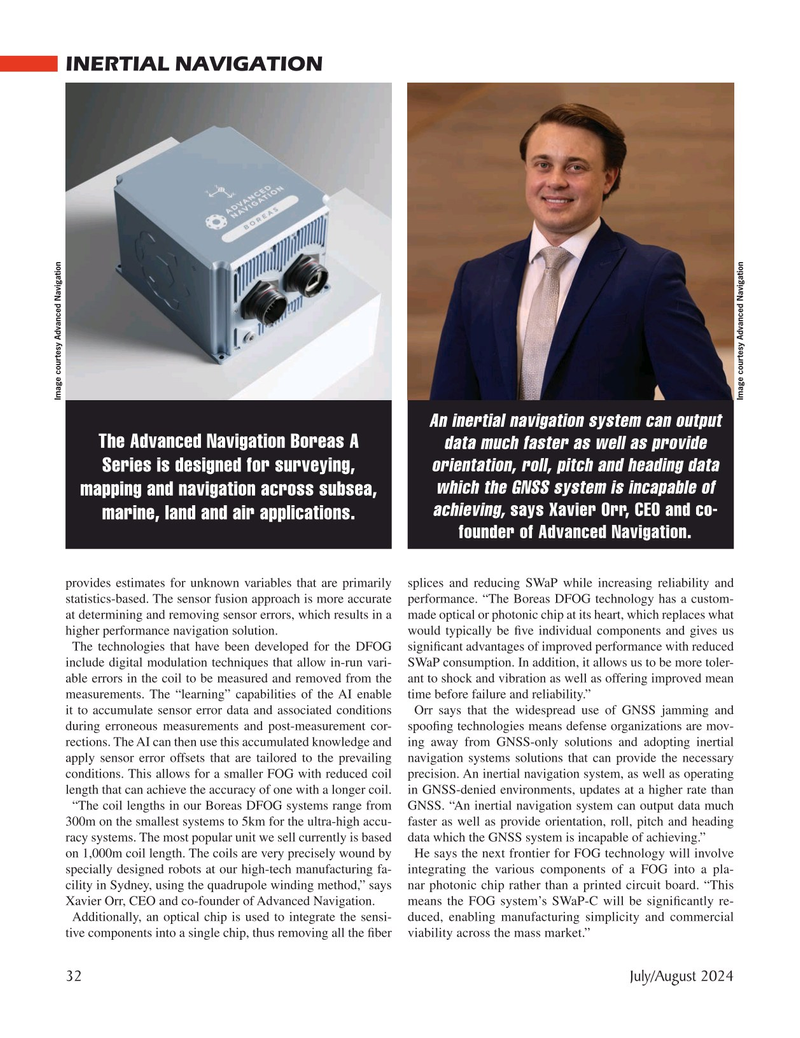
Page 32: of Marine Technology Magazine (July 2024)
Read this page in Pdf, Flash or Html5 edition of July 2024 Marine Technology Magazine
INERTIAL NAVIGATION
Image courtesy Advanced Navigation
Image courtesy Advanced Navigation
An inertial navigation system can output
The Advanced Navigation Boreas A data much faster as well as provide orientation, roll, pitch and heading data
Series is designed for surveying, which the GNSS system is incapable of mapping and navigation across subsea, achieving, says Xavier Orr, CEO and co- marine, land and air applications. founder of Advanced Navigation. provides estimates for unknown variables that are primarily splices and reducing SWaP while increasing reliability and statistics-based. The sensor fusion approach is more accurate performance. “The Boreas DFOG technology has a custom- at determining and removing sensor errors, which results in a made optical or photonic chip at its heart, which replaces what higher performance navigation solution. would typically be ? ve individual components and gives us
The technologies that have been developed for the DFOG signi? cant advantages of improved performance with reduced include digital modulation techniques that allow in-run vari- SWaP consumption. In addition, it allows us to be more toler- able errors in the coil to be measured and removed from the ant to shock and vibration as well as offering improved mean measurements. The “learning” capabilities of the AI enable time before failure and reliability.” it to accumulate sensor error data and associated conditions Orr says that the widespread use of GNSS jamming and during erroneous measurements and post-measurement cor- spoo? ng technologies means defense organizations are mov- rections. The AI can then use this accumulated knowledge and ing away from GNSS-only solutions and adopting inertial apply sensor error offsets that are tailored to the prevailing navigation systems solutions that can provide the necessary conditions. This allows for a smaller FOG with reduced coil precision. An inertial navigation system, as well as operating length that can achieve the accuracy of one with a longer coil. in GNSS-denied environments, updates at a higher rate than “The coil lengths in our Boreas DFOG systems range from GNSS. “An inertial navigation system can output data much 300m on the smallest systems to 5km for the ultra-high accu- faster as well as provide orientation, roll, pitch and heading racy systems. The most popular unit we sell currently is based data which the GNSS system is incapable of achieving.” on 1,000m coil length. The coils are very precisely wound by He says the next frontier for FOG technology will involve specially designed robots at our high-tech manufacturing fa- integrating the various components of a FOG into a pla- cility in Sydney, using the quadrupole winding method,” says nar photonic chip rather than a printed circuit board. “This
Xavier Orr, CEO and co-founder of Advanced Navigation. means the FOG system’s SWaP-C will be signi? cantly re-
Additionally, an optical chip is used to integrate the sensi- duced, enabling manufacturing simplicity and commercial tive components into a single chip, thus removing all the ? ber viability across the mass market.” 32 July/August 2024
MTR #5 (18-33).indd 32 7/23/2024 2:01:34 PM

 31
31

 33
33
